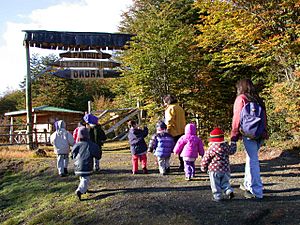Omora Ethnobotanical Park facts for kids
The Omora Ethnobotanical Park is a special protected area in Chile. It's located about 4 km (2 mi) west of Puerto Williams on Navarino Island. This park is in the very southern part of the Magellan and Chilean Antarctica Region.
Omora Park is a place for research, education, and protecting nature. It's a key part of the Cape Horn Biosphere Reserve. The park has many different kinds of plants from the subantarctic region. It's open to everyone for learning, both in school and just for fun. Inside the park, you can find forests with trees that lose their leaves, like Nothofagus antarctica and Nothofagus pumilio. There are also forests with trees that stay green all year, like Nothofagus betuloides. You'll also see bogs (wet, spongy areas) and high-mountain ecosystems. Scientists at Omora Park call the many different mosses, lichens, and liverworts found here the "Miniature Forests of Cape Horn."
Since it started in 2000, Omora Park has worked with many partners. They have led a big effort to protect both nature and culture. This work helped create the Cape Horn Biosphere Reserve. Many groups now support this program. These include the Omora Foundation, the Millennium Institute of Ecology and Biodiversity (IEB-Chile), and the University of Magallanes in Chile. In the United States, the University of North Texas and the Center for Environmental Philosophy also help. In 2008, Omora Park won a special award for its work in science and society.
Contents
Learning About Nature and Philosophy
The park's founder, Dr. Ricardo Rozzi, started a unique way of learning called "field environmental philosophy." This means learning about nature by being out in it. It's a bit like how ancient Greek thinkers used to walk and talk about ideas.
Experiencing Nature Up Close
This way of learning invites people to truly experience nature. It helps them see how special each living thing is. It's not just about scientific names or numbers. It helps students, teachers, scientists, and even leaders understand the true value of every single living being. This kind of learning helps people feel connected to nature. It also makes them want to protect different kinds of plants and animals and their homes.
Tourism with a Hand Lens
One great example of how Omora Park connects ideas with real-life action is the Tourism with a Hand Lens program. This program encourages visitors to explore the tiny details of nature using a magnifying glass. It helps people see the "Miniature Forests" and other small wonders up close. This hands-on experience helps people appreciate the small but important parts of the ecosystem.
Working with the Community
Even with all its achievements, Omora Park has had some discussions with the local community. In 2009, leaders from four local groups wrote a public letter. These groups included the Cape Horn Tourism Association and the Puerto Williams Fisherman's Union. They questioned the park's growth and its role with the local people.
Community Support for the Park
However, most members of the Regional Council supported Omora Park's plans. Many other public and private groups also supported the park. This included the President of the Yahgan Community of Mejillones Bay. This shows that many people believe in the park's mission.
Articles online
- Omora Biocultural Conservation Approach: Ecology & Society 2006
- Field environmental philosophy and biocultural conservation at the Omora Ethnobotanical Park: Methodological approaches to broaden the ways of integrating the social component(“S”) in Long-Term Socio-Ecological Research (LTSER) Sites
Videos online
- The invisible Journey: Ecotourism with a Hand-Lens
- Parque Omora: Laboratorio Natural by TVN - CONICYT - CABALA
- La Medida de Omora by Claudia Esslinger
- La Medida de Omora y Los Cabos de Hornos by Claudia Esslinger
- Field Environmental Philosophy /Filosofia Ambiental de Campo: El Retorno a la Madriguera (The Return to the Den) by Jaime Sepulveda
- Belleza de Pensar Cristian Warnken, Lorenzo Aillapán y Ricardo Rozzi
- Efecto Picaflor
- Efecto Picaflor sinopsis
- TV UMAG Ecotourism with a Hand Lens - Ecoturismo con Lupa
- TV UMAG Omora LA BIODIVERSIDAD
- TV UMAG Omora VALOR INTRINSECO
- TV UMAG Omora VALOR INSTRUMENTAL
- TV UMAG Omora Turismo sustentable Parque Cabo de Hornos
- TV UMAG Omora Guia Multi Etnica de Aves Subantarticas
- Naturaleza Pajaro, Bosque Nativo - Lorenzo Aillapan by Olaf Pena Pastene
- Naturaleza Pajaro, Bosque Nativo - Ricardo Rozzi by Olaf Pena Pastene
See also
 In Spanish: Parque etnobotánico Omora para niños
In Spanish: Parque etnobotánico Omora para niños


